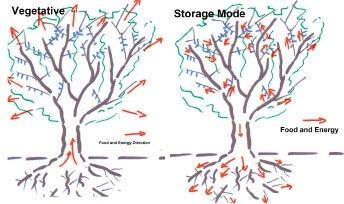Each season trees work hard to convert sunlight into carbohydrates in the leaves, and at the relevant time, send this ‘food’ into the developing fruit to give us our crop.
Food movement is all about the points of demand—and the signals that determine food movement are sent by hormones.
Hormones determine the greatest ‘sink’ for food at different growth stages, and these sinks change in strength. The food can be directed to vegetation, or to the fruit, or at times the strongest sink is from the roots and storage tissue.
The hormone signals in the plant are quite complex. It is more the ratio of one hormone to another, rather than the absolute amount of hormone, that determines the transfer of food to each site.
The main hormone that directs food is IAA. When IAA moves down from the vegetation, sugar and carbohydrates move in the opposite direction (up to the shoots). When IAA moves from the fruit, food (sugar and carbohydrates) move in the opposite direction (into the fruit).
Harvest time
Leading up to harvest, if we have the crop managed properly, we hope that most of the food has been moving to the fruit. This is where the production comes from.
If there is a big fruit load, we hope that the fruit is sending IAA out and receiving food from the leaves in return.
We know that too much late vegetative growth can lessen the trees ability to size its fruit. This is because the vegetative growth competes with the fruit for food.
When we harvest the fruit, we suddenly lose the largest sink. The trees are still producing food and the food has to go somewhere.
Where will the food go now? It will go to the point that is presenting the next biggest sink.
It will be most likely shared amongst the vegetation, the roots and the storage tissue in the tree.
Where do we want it to go?
Well, we don’t want it to move to the vegetative growth because that will be falling on the ground soon.
We want it to move to the roots and storage tissue. The storage tissue includes the buds that will be important next season—so it helps if they are furnished with food.
Movement to the roots keeps the roots alive for longer and keeps their ability to supply water and nutrients to the trees as they approach dormancy.
What does this mean in practice?
(continues next month)
For information, see Tree Fruit April 2014






















